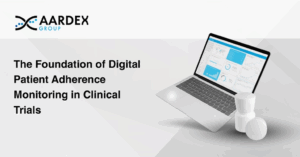If 2020 brought the challenges of 21st-century healthcare to the fore, 2021 has been the year of building the case for a new approach.
But as we look ahead to 2022, how can we take what we have learned since the start of the pandemic and apply it to solving medicine and pharma, asks Bernard Vrijens, CEO and Scientific Lead at AARDEX Group.
Tackling the spiraling costs of developing life-changing drug products and delivering routine healthcare while ensuring equal and equitable access to all has been on the sector’s “to do” list for some time.
And while digital transformation has long been mooted as at least part of the solution, adoption has been slow. Decision-makers often point to a lack of robust evidence for the use of innovations such as remote monitoring, the automation of repetitive tasks, and mHealth.
During the COVID-19 pandemic, however, healthcare ecosystems had no choice but to embrace digital solutions.
In a bid to keep services and clinical trials up and running despite infection control measures, healthcare teams turned to video consultations and researchers to decentralized clinical trials in their droves.
This rapid acceleration in the use of digital has created a “use case” gold mine which will only serve to feed an ever-growing pipeline of evidence-based innovations.
Research-Specific Challenges
The clinical trial industry is facing a raft of challenges, from the spiraling cost of research to the growing complexity of drug products and trial design.
Optimizing drug development, to reduce time to market and increase return on investment, while still protecting participant safety, has become paramount in recent years.
There is an urgent need to expand access to clinical trials, to deliver the diversity and representation that are crucial to providing equal access to care, protect the future of precision medicine, and overcome the age-old problem of low recruitment and high dropout rates.
COVID-19, and our response to it, has shone a light on the issue of health inequalities. That some groups of people have poorer health outcomes simply by virtue of their socioeconomic status has become common knowledge.
This inequality starts right at the beginning of the healthcare pipeline, in clinical trials, where people from black and ethnic minority backgrounds are frequently underrepresented.
At the same time, the personalized medicine revolution is leading to truly innovative medicines that could hinge on a single genetic mutation, and restrict the pool of eligible participants.
All this is set to the historic backdrop of recruitment and retention challenges that sponsors are only too aware of.
The digitalization of clinical trials, including decentralized research models, holds the key to overcoming these barriers. By expanding access and streamlining processes, it could enable the industry to catch up on lost time, following the pandemic.
Digital Transformation
A huge variety of digital health services and applications designed to improve study conduct have been developed in recent years.
From electronic data capture to wearable sensors, each one of these has the potential to streamline or optimize one element of a clinical trial.
But no element has a larger impact on the chances of study success than medication adherence, a long-standing problem that affects a staggering 50% of all trial participants, and can have devastating consequences.
The literature shows that the primary source of trial failure over the last 30 years has been an inability to demonstrate efficacy[1] However, this does not always mean the drug does not work – poor adherence can result in uncertainties around dose selection, or drain study power, for example.2
Safety is another leading root cause of failure[3] but this outcome doesn’t necessarily mean the drug is unsafe. Incorrect dosing derived from poor adherence, for instance, can result in adverse events that do not accurately reflect the effect of the product[2]
Ultimately, the reasons for study failure are as varied and complex as the trials themselves. Yet there is a common thread that runs through the most common factors of efficacy, safety, and dose selection, and that is poor medication adherence.
Despite its magnitude, taking hold of the issue has proved challenging. Sponsors and CROs have been forced to rely on subjective, biased methods such as pill counts, blood sampling, and HCP or self-reporting. These approaches are simply not sensitive enough to provide real value.
Here at ARRDEX, we believe the digital transformation of adherence management is key to building safe, robust, efficient clinical trials. That’s why we have developed a digital adherence monitoring ecosystem that holds huge potential for the future of pharmaceutical development.
Digital adherence monitoring is a world away from the traditional methods we have all become used to. It combines smart packaging and powerful analytics to measure and help site teams manage medication adherence.
Rather than relying on biased, subjective methods, it provides the objective, robust information that site teams need to spot people who might need additional support to stay on track. What’s more, the approach is complementary to remote or hybrid trials, making it an important piece in the “expanding access” jigsaw.
2022: The Next Frontier
Individualized care is our biggest opportunity, and technological innovation is the key to unlocking this potential.
If we are to move to the next frontier of healthcare and finally solve the problem of spiraling costs and narrow access, we need to move practice-changing tools, such as digital adherence monitoring, into routine workflows.
This will require a whole system approach that trains and reassures the workforce, builds and deploys the required infrastructure, and sets standards for system interoperability. We also need alignment of legislation and policy across regions.
With digitally enabled, integrated person-centered solutions, we could transform healthcare and improve outcomes for every single patient, regardless of who they are or where they come from.
And that should be our focus for 2022.
[1] Fogel, D. Factors associated with clinical trials that fail and opportunities for improving the likelihood of success: A review. (2018). https://www.ncbi.nlm.nih.gov/pmc/articles/PMC6092479/
[2] Berlin, J., Glasser, S. et al. Adverse event detection in drug development: recommendations and obligations beyond Phase 3. (2008). https://www.ncbi.nlm.nih.gov/pmc/articles/PMC2446471/
[3] (2008). https://www.ncbi.nlm.nih.gov/pmc/articles/PMC2446471/



